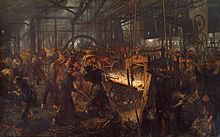This article needs additional citations for verification. (April 2013) |


An ironworks or iron works is an industrial plant where iron is smelted and where heavy iron and steel products are made. The term is both singular and plural, i.e. the singular of ironworks is ironworks.
Ironworks succeeded bloomeries when blast furnaces replaced former methods. An integrated ironworks in the 19th century usually included one or more blast furnaces and a number of puddling furnaces or a foundry with or without other kinds of ironworks. After the invention of the Bessemer process, converters became widespread, and the appellation steelworks replaced ironworks.
The processes carried at ironworks are usually described as ferrous metallurgy, but the term siderurgy is also occasionally used. This is derived from the Greek words sideros - iron and ergon or ergos - work. This is an unusual term in English, and it is best regarded as an anglicisation of a term used in French, Spanish, and other Romance languages.
Historically, it is common that a community was built around the ironworks where the people living there were dependent on the ironworks to provide jobs and housing. [1] As the ironworks closed down (or was industrialised) these villages quite often went into decline and experienced negative economic growth. [2]
- ^ Roos, Annie (2021). "Reproducing gender - The spatial context of gender in entrepreneurship". pub.epsilon.slu.se. Retrieved 2022-04-21.
- ^ Roos, Annie; Gaddefors, Johan (2022-04-07). "In the wake of the ironworks - entrepreneurship and the spatial connections to empowerment and emancipation". The International Journal of Entrepreneurship and Innovation: 146575032210898. doi:10.1177/14657503221089802. ISSN 1465-7503. S2CID 248043339.